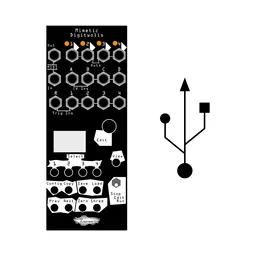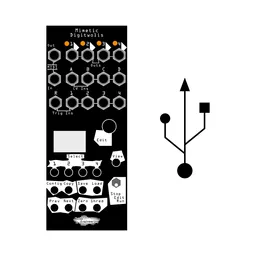Yes.
We’re serious.
You read that right.
Virt Iter Legio, the most highly anticipated 6HP oscillator in NE history, is finally here. Even better, it’s got a friend: Librae Legio. We’ll do a deep dive on Librae Legio next week but for today, we’ll let you know you can buy both of them NOW and put them in your rack and make music with them. Or buy one and try them both: just like Versio, it’s a firmware-swappable platform!
Today, we’ll talk about our newest platform, Legio, and Virt Iter Legio.
Hey Noise Eng, What is a platform module?
In the Noise Engineering universe, a platform is a single module that can be many things, and all you have to do to change it is swap the firmware at our Customer Portal, completely free of charge. If you’re familiar with our Versio line, you’ve seen platforms already: Versio, at time of writing, has seven official firmwares available. And because we offer open-source support on libDaisy, you can write your own firmware if you’re so-inclined, or you can check out one of the community firmwares too. That’s right, if you buy one, you can try them all. Your Desmodus can be your Ruina, or Electus your Ampla.
Similarly, the Legio is a platform: at release, we have the Virt Iter oscillator firmware and the Librae dynamics processor firmware, as well as open-source support through libDaisy, and so much more planned.
If you’re developing your own firmware for the Legio platform, you have Eris to thank, as she laid the groundwork for open-source firmware design. Eris Fairbanks is a transgender music hacker, hardware designer, and shader sorceress. She pushes digital artifacts into the ether as conestutter and is currently working on projects for Olivia Artz Modular.
Virt Iter Legio: it’s a whole lot of oscillator in a small footprint

Virt Iter Legio is a stereo oscillator with three algorithms and a unique feature set that make it great for pretty much any system. Whether you need a versatile sound source for a small skiff or a flexible oscillator for a large system, Virt Iter Legio offers a whole lot, especially for its size. We loved the sound of these oscillator algorithms so much that we put them in a VST plugin and contributed them to the Arturia MicroFreak. They’re tried and tested, and with the unique patching options of a Eurorack system, you’ll be making some badass sounds as soon as it’s plugged into your case.
3 times the algorithm, 3 times the fun
Virt Iter Legio’s three oscillator algorithms are as unique as they are fabulous. We have talked about these in detail elsewhere so if you want the technobabble behind them, have a look. Here, we’ll do a quick overview.
Bass: pronounced like a fish and named after a person, not the clef, it has some awesome low end. It was inspired by an algorithm described in Electronotes, with a few Noise Engineering touches (fold anyone?) for more edgy sounds. I often pair it with a lowpass gate for big plucks (and, of course, the occasional bassline).
The SawX algorithm starts with a simple super-saw oscillator, and adds some saw-mod that can be beautiful or absolutely hardcore. You may recognize some timbral similarities to the Manis Iteritas: we love saws here at NE, and SawX is useful across a huge range of frequencies. I tend to use it for low-end duties, but as you can hear in the manual video below it’s also a wonderful choice for melodies as well.
Finally, Harm is an additive algorithm with a digital interpretation of something similar to our analog Pura Ruina module. With lower settings, it’s downright beautiful, but crank the Tang knob to add in a bit of noise, if you need some crunch. Modulating Flavor with an LFO is mesmerizing and perfect for drones.
Simple necessities: sync, 1v/8va, CV
An oscillator wouldn’t be complete without some standard features: Virt Iter Legio includes a hardsync input for use in conjunction with other oscillators, CV over Tang and Flavor, and, of course, a one volt per octave pitch CV input with a -2v to +5v.
Stereo phase modulation? In this economy?
We’ve mentioned that Virt Iter Legio is a stereo oscillator: its algorithms all sound great in the stereo field, and its vintage-inspired chorus is lovely and wide. But that's not all VIL has left-and-right phase-modulation inputs!
If you want to create some more traditional phase-modulation sounds, patch an external oscillator to the L input: this input normals to the R and both sides will be modulated and you’ll be well on your way to wonderful PM timbres. Why not get really wild though, and use completely separate signals at the L and R inputs? I like using two separate oscillators, as that allows for some unique different-but-related sounds to be created in the left-and-right channels. Or give more subtle width to a PM sound with a traditional multi-output oscillator: just patch different waveforms to each input.
The ability to independently modulate the channels is one of the most unique features of Virt Iter Legio, and not something that you’ll find in many other modules – it’s a very cool way of creating width in a sound and one of my personal favorite techniques to use in my patches these days.
See Virt Iter Legio in action
As usual, we’ve done a lot of talking here, so let’s get some sounds going. Check out the official manual video showing off just a few of the things Virt Iter Legio can do:
The history of Virt Iter Legio
Virt Iter Legio’s story starts in January of 2019 when we met with a few lovely people at Arturia. They were about to announce the MicroFreak, and were interested in what we could do and we were interested in the challenge, and of course in working with them -- they were wonderful.
Part of the agreement was that we could release the oscillators we contributed to the MicroFreak as a product of our own. Once we had a working version for them, we set about creating a hardware form. We knew we wanted it to be small and stereo, so immediately we were at 6hp. We laid it out in now time and had a prototype called Virt Iter. “This is ready to launch,” we said. “We’ll show this at NAMM 2020,” we said.
Mmm hmmm.
The pandemic slowed things to a crawl, the parts shortages started, a certain codec factory burned down, etc., etc. We had to redesign the entire platform from the ground up.
A couple of times.
In the meantime, we were so enamored with these sounds that we put them into our Virt Vereor plugin. Sometimes, you need that in-the-box repeatability and with Virt Vereor, you have it.
But we still loved the tactile nature of the module! So eventually, we put together a final design that we could actually manufacture, and spent a few months developing firmware. We finalized the Virt Iter firmware and decided on the Legio name for the platform itself (and created Librae – more on that next week).
And then, shortly before we were scheduled to build out the first run, a flaw in the hardware that had somehow slipped under the radar was found, and we had to do another revision. But then we were done! And Legio made its way into the world.
The week of launch, we had a micro freak out when we thought our pitch calibration wasn’t working right. Also the printer for the panels broke down. We considered an exorcism and sacrifices to various deities, but it turned out that the calibration issue was just a miscommunication, and the printer magically healed itself the next day (note: always try the turn it off and back on again option).
We appreciate all the comments and emails we’ve received since Virt Iter Legio was first announced. We’re just as excited as you are that it’s finally released, and we hope you enjoy it. We’re quite proud of how it turned out, and we have a whole lot of exciting plans for the platform.
Get your Virt Iter Legio






